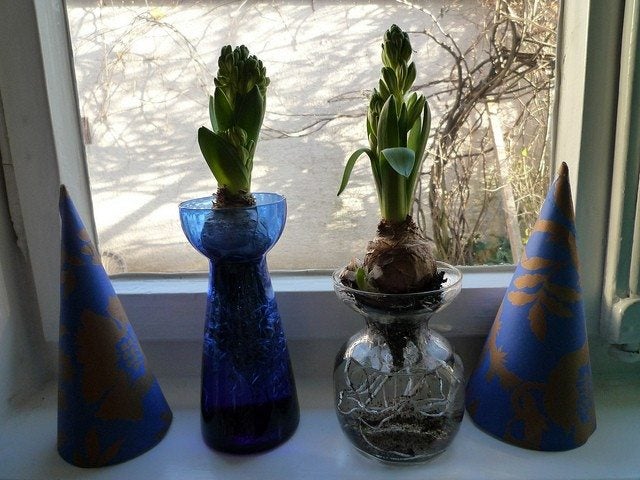Hyacinth Forcing Indoors: How To Force A Hyacinth Bulb

All plants that flower do so at a particular time according to their kind. However, it is possible to make a plant flower at a time other than its naturally occurring time when the proper, artificial conditions are created. This process is known as forcing and is often used by commercial flower growers. Certain cultivars of hardy bulbs are well suited to forcing. Crocuses, daffodils, and hyacinths are among the easiest and most popular of plants that respond well to forcing. This article will focus on forcing hyacinth bulbs. Forcing hyacinth bulbs is not a difficult task as long as you start with an appropriate cultivar for forcing and a healthy bulb. Healthy hyacinth flower bulbs are large and firm. Be sure to pick a bulb that will fit into your chosen container and always wear gloves when handling the bulbs as they contain oxalic acid, which can cause irritation to the skin.
How to Force a Hyacinth Bulb
In order for forcing hyacinth bulbs to be successful, bulbs must be chilled for 13 weeks. If bulbs are not permitted to chill for the appropriate amount of time, the bulb will not bloom. Hyacinth forcing indoors also requires the use of a well-drained potting medium. A suitable mixture of equal parts of peat, sand, and loamy soil works well. Do not add fertilizer to the mixture. Use only clean pots that have adequate drainage holes. A good pot size is 4 to 8 inches (10 to 20.5 cm.) in diameter. If you are using a pot that has been previously used, be sure to clean the pots thoroughly to eliminate the spread of pathogens. If you use a clay pot, soak the pot in water overnight so that they do not pull moisture from the potting soil.
Planting Care of Forced Hyacinths
Plant the bulbs anywhere from September through December, depending on when you want the flower to bloom. It takes a total of 16 weeks for the plant to bloom, including the chill time. Handle bulbs with caution. If you cannot plant the bulbs right away, put them in a brown paper bag with the bag left open. Store the bulbs at a temperature of 45 to 50 F. (4-10 C.). Bulbs will keep for up to three weeks if stored in proper conditions. Fill your chosen container with at least 2 inches (5 cm.) of planting medium. Do not pack the soil onto the bulb but keep it loose. Cover the bulb entirely. Plant one bulb in a 4-inch (10 cm.) container, three bulbs in a 6-inch (15 cm.) container, and more in larger containers. Bulbs can be planted as close together as necessary. Hyacinth forcing indoors can also be done in water. Choose a container without drainage holes that are anywhere from 3 to 5 inches )(7.5 to 12.5 cm.) deep. Fill the container half full of clean pebbles and place the hyacinth flower bulbs atop this material so that they almost touch. Gently surround the bulbs with additional material to anchor them and add water until it reaches the bottom of the bulbs. Place the container in a cool, dark location for two weeks and then move to a warmer, sunny area. Replenish with water as needed.
Caring for Forced Hyacinth Flower Bulbs
After the bulbs are planted, water them thoroughly so that the water drains out of the container's drainage holes. Place them in a cooler that is between 35 and 45 F. (2-7 C.). Keep the soil moist during the cooling period. Roots will form and grow out of the holes in the bottom of the container after five or six weeks and shoots soon afterward. Remove the bulbs from cold storage after 13 weeks. For best results, keep the plants in a room that is 60 F. (16 C.) and do not place the plant in direct sunlight. It is not necessary to fertilize the bulb. Bulbs will bloom within three weeks of being taken out of cold storage.
Sign up for the Gardening Know How newsletter today and receive a free copy of our e-book "How to Grow Delicious Tomatoes".